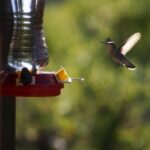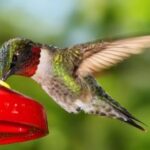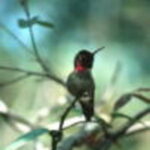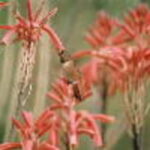Even though the state of Maine is not widely known for its hummingbird population, two species visit this state annually. These are the Ruby-throated Hummingbird and the Rufous Hummingbird. These species begin their arrival in Maine in early May with the males arriving first followed by the females a week or two later. These species of hummingbirds will begin leaving toward the end of September with male first again. Females and juveniles begin leaving about two weeks later.
Learning to tell the difference between these two species of hummingbirds is both easy and hard. The easy part is if the bird in question is a male, especially a Ruby-throated Hummingbird because they are identifiable by their unmistakable by their ruby red throat, forked tail and emerald green back. The male Rufous Hummingbird is identified by its rufous colored crown, tail and sides along with its bright orange-red throat and white breast. The females of these two species not near as colorful as their male counterparts but can also be identified by the colors of the feathers that cover their bodies. The female Ruby-throated Hummingbird has an emerald green back just like the male, but has a white breast and throat and a round tail instead of a forked tail. The female Rufous Hummingbird has a green back and crown, but it is not emerald green like the male and female Ruby-throated Hummingbird. The female Rufous Hummingbird also has a white breast, a throat that is streaked and tail feathers that are rufous with white tips.
Hummingbirds in Maine are attracted to hummingbird gardens that include annuals, perennials, vines, trees and shrubs. Annuals that should be included in a Maine hummingbird garden are Fuchsia, Spotted jewelweed, blue thimble flower, flame flower, French marigold singles, flowering tobacco, geranium, Mexican sunflower, Nasturtium, petunia with single blossoms, pincushion flower, portulaca, scarlet runner bean, scarlet sage and Zinnia. Perennials to include are bluebells, butterflyweed, hollyhock, iris, wild or Canada columbine, European columbine, delphinium, foxglove, fireweed, dwarf blue gentian, red gladiolus, daylily, coral bells, hosta, blazing star, turk’s cap lily, wood lily, cardinal flower, bee balm. Other perennials to include are Oswego tea, wild bergamot, Penstemon, moss pink, wild blue phlox, phlox, showy evening primrose, Virginia creeper, cup plant, bugleweed, globe thistle, tulip, Maltese cross and Japanese bleeding heart. Trees, shrubs and vines to include in a Maine hummingbird garden are scarlet trumpet vine, northern catalpa, brown’s honeysuckle, fly honeysuckle, coralberry, old-fashioned weigela, New Jersey tea, cockspur hawthorn, Washington hawthorn, apples and crabapples, rhododendrons and azaleas, shadbush, flowering cherry trees, virginbower, tuliptree, flowering quince, horse chestnut, hybrid dematis, butterfly bush, rose of Sharon and lilacs.
Hummingbird enthusiasts in Maine can enjoy at least two species of hummingbirds annually, even if they do not have the same length of time to do so as other states, especially the southern states. With careful planning of a hummingbird garden and carefully placed hummingbird feeders these hummingbird enthusiasts will have many pleasant sightings each year as these little birds become temporary residents of Maine, if only for a short time.







